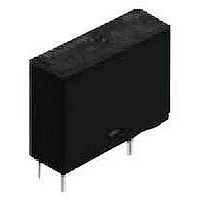ALTS3125 PANASONIC EW, ALTS3125 Datasheet - Page 4

ALTS3125
Manufacturer Part Number
ALTS3125
Description
POWER RELAY, 12VDC, 5A, SPST-NO, PCB
Manufacturer
PANASONIC EW
Datasheet
1.ALTS3055.pdf
(4 pages)
Specifications of ALTS3125
Relay Type
Power
Coil Voltage Vdc Nom
12V
Contact Current Max
5A
Contact Voltage Dc Nom
12V
Coil Resistance
514ohm
Contact Configuration
SPST-NO
Coil Type
DC
Coil Current
23.3mA
Panasonic Electric Works Co., Ltd.
LT-S
NOTES
conditions
1) Temperature:
–40 to +70°C
2) Humidity: 5 to 85% RH
(Avoid freezing and condensation.)
The humidity range varies with the
temperature. Use within the range
indicated in the graph below.
3) Atmospheric pressure: 86 to 106 kPa
Temperature and humidity range for
usage, transport, and storage
4) Condensation
Condensation forms when there is a
sudden change in temperature under
high temperature and high humidity
conditions. Condensation will cause
deterioration of the relay insulation.
5) Freezing
Condensation or other moisture may
freeze on the relay when the
temperatures is lower than 0°C 32°F. This
causes problems such as sticking of
movable parts or operational time lags.
6) Low temperature, low humidity
environments
The plastic becomes brittle if the relay is
exposed to a low temperature, low
humidity environment for long periods of
time.
1) Please obey the following conditions
when soldering automatically.
(1) Preheating: Within 120°C
(solder surface terminal portion) and
within 120 seconds
(2) Soldering iron: 260°C±5°C
500°F±41°F
within 6 seconds (soldering time)
2) Since this is not a sealed type relay, do
not clean it as is. Also, be careful not to
allow flux to overflow above the PC board
or enter the inside of the relay.
Automation Controls Business Unit
4
panasonic-electric-works.net/ac
Head Office: 1048, Kadoma, Kadoma-shi, Osaka 571-8686, Japan
Telephone: +81-6-6908-1050
Usage, transport and storage
Solder and cleaning conditions
(Avoid freezing
when used at
temperatures
lower than
0°C 32°F)
–40
–40
Tolerance range
(solder temperature) and
Temperature, °C
–40 to +158°F
85
5
+32
0
(Avoid
condensation
when used at
temperatures
higher than
0°C
Humidity, %R.H.
32°F)
°F
+158
248°F
Facsimile: +81-6-6908-5781
70
1) This relay is UL and C-UL certified.
UL and C-UL standards: TV-5
2) This relay is certified by VDE as an
electromagnetic relay that complies with
EN61810-1.
VDE standards: TV-5
3) This relay is certified by SEMKO.
10/80 A 250 V AC 40T85µ, 10,000 times
(Steady-state current: 10A/Inrush
current: 80 A, Load voltage: 250 V AC,
Ambient temperature: –40 to +85°C
to
3/120 A 250 V AC 40T85µ, 10,000 times
(Steady-state current: 3A/Inrush current:
120 A, Load voltage: 250 V AC, Ambient
temperature: –40 to +85°C
+185°F, Micro-gap)
1) For precautions regarding use and
explanations of technical terminology,
please refer to our web site.
(panasonic-electric-works.net/ac)
2) To ensure good operation, please keep
the voltage on the coil ends to ±5% (at
20°C 68°F) of the rated coil operation
voltage. Also, please be aware that the
pick-up voltage and drop-out voltage may
change depending on the temperature
and conditions of use.
3) Keep the ripple rate of the nominal coil
voltage below 5%.
4) The cycle lifetime is defined under the
standard test condition specified in the
JIS C 5442 standard (temperature 15 to
35°C
Check this with the real device as it is
affected by coil driving circuit, load type,
activation frequency, activation phase,
ambient conditions and other factors.
Also, be especially careful of loads such
as those listed below.
(1) When used for AC load-operating and
the operating phase is synchronous.
Rocking and fusing can easily occur due
to contact shifting.
(2) Highly frequent load-operating
When highly frequent opening and
closing of the relay is performed with a
5 A 277 V AC, 50,000 times
8 A 277 V AC, 10,000 times
5 A 250 V cos φ = 1.0, 50,000 times
8 A 250 V cos φ = 1.0, 10,000 times
+185°F, Micro-gap)
5 A 250 V cos φ = 1.0, 50,000 times
8 A 250 V cos φ = 1.0, 10,000 times
Certification
Others
59 to
95°F, humidity 25 to 75%).
–40 to
All Rights Reserved © 2010 COPYRIGHT Panasonic Electric Works
–40
load that causes arcs at the contacts,
nitrogen and oxygen in the air is fused by
the arc energy and HNO
can corrode metal materials.
Three countermeasures for these are
listed here.
• Incorporate an arc-extinguishing circuit.
• Lower the operating frequency
• Lower the ambient humidity
5) This value can change due to the
switching frequency, environmental
conditions, and desired reliability level,
therefore it is recommended to check this
with the actual load.
6) Heat, smoke, and even a fire may
occur if the relay is used in conditions
outside of the allowable ranges for the
coil ratings, contact ratings, operating
cycle lifetime, and other specifications.
Therefore, do not use the relay if these
ratings are exceeded.
7) If the relay has been dropped, the
appearance and characteristics should
always be checked before use.
8) Incorrect wiring may cause
unexpected events or the generation of
heat or flames.
9) There are no restrictions as to how this
relay should be oriented during
installation. However, due to gravitation
there may be slight differences in pick-up/
drop-out voltage and operate/release
time, etc., depending on the orientation.
Therefore, when evaluating the relay,
please do so with the relay installed with
the actual orientation.
Specifications are subject to change without notice.
ASCT1B391E 201010-3YT
3
is formed. This
Printed in Japan.















